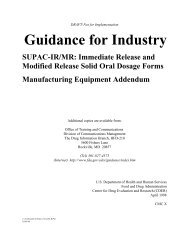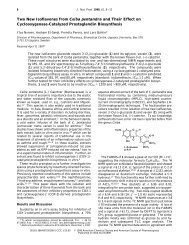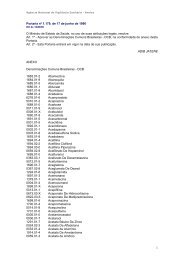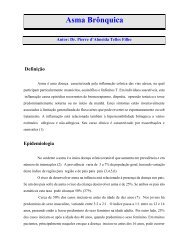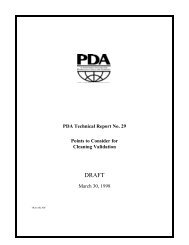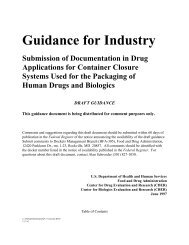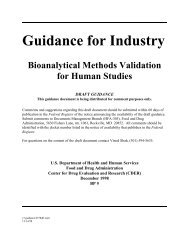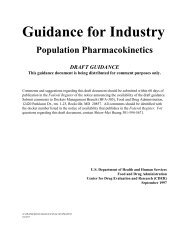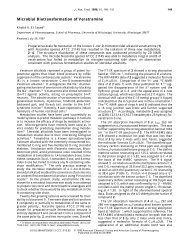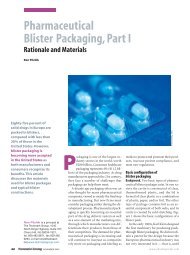ANDAs impurities in drug substances - Pharmanet
ANDAs impurities in drug substances - Pharmanet
ANDAs impurities in drug substances - Pharmanet
- No tags were found...
Create successful ePaper yourself
Turn your PDF publications into a flip-book with our unique Google optimized e-Paper software.
Draft-Not for ImplementationGuidance for Industry<strong>ANDAs</strong>: Impurities <strong>in</strong> DrugSubstancesDRAFT GUIDANCEThis guidance document is be<strong>in</strong>g distributed for comment purposes only.Comments and suggestions regard<strong>in</strong>g this draft document should be submitted with<strong>in</strong> 60 days ofpublication <strong>in</strong> the Federal Register of the notice announc<strong>in</strong>g the availability of the draft guidance.Submit comments to Dockets Management Branch (HFA-305), Food and Drug Adm<strong>in</strong>istration,12420 Parklawn Dr., rm. 1-23, Rockville, MD 20857. All comments should be identified withthe docket number listed <strong>in</strong> the notice of availability that publishes <strong>in</strong> the Federal Register.Additional copies of this draft guidance are available from the Drug Information Branch, Divisionof Communications Management, HFD-210, 5600 Fishers Lane, Rockville, MD 20857, (Tel)301-827-4573, or from the Internet at http://www.fda.gov/cder/guidance/<strong>in</strong>dex.htm.For questions on the content of the draft document, contact Robert W. Trimmer, Ph.D.,(301) 827-5848U.S. Department of Health and Human ServicesFood and Drug Adm<strong>in</strong>istrationCenter for Drug Evaluation and Research (CDER)June 1998CMC #J:\!GUIDANC\2452DFT.WPDJuly 21, 1998
Draft-Not for ImplementationTABLE OF CONTENTSI. INTRODUCTION .....................................................1II. CLASSIFICATION OF IMPURITIES .....................................3III. RATIONALE FOR THE REPORTING AND CONTROL OF IMPURITIES ........3A. Organic Impurities ...............................................3B. Inorganic Impurities ..............................................4C. Residual Solvents ................................................5IV. ANALYTICAL PROCEDURES ..........................................5V. REPORTING IMPURITY CONTENT OF BATCHES .........................5VI. ACCEPTANCE CRITERIA FOR IMPURITIES ..............................6VII. QUALIFICATION OF IMPURITIES ......................................8VIII. NEW IMPURITIES ...................................................11ATTACHMENT I — Impurities Decision Tree (Generic Drugs) .......................12ATTACHMENT II — ICH Decision Tree for Safety Studies .........................13ATTACHMENT III — Glossary of Terms .......................................14J:\!GUIDANC\2452DFT.WPDJuly 21, 1998i
Draft-Not for ImplementationGUIDANCE FOR INDUSTRY 1<strong>ANDAs</strong>: Impurities <strong>in</strong> Drug Substances(Due to the length and complexity of this draft document,please identify specific comments by l<strong>in</strong>e number.)123456789101112131415I. INTRODUCTIONThis guidance provides recommendations for <strong>in</strong>clud<strong>in</strong>g <strong>in</strong>formation <strong>in</strong> abbreviated new <strong>drug</strong>applications (<strong>ANDAs</strong>) and support<strong>in</strong>g <strong>drug</strong> master files (DMFs) on the identification andqualification of <strong>impurities</strong> <strong>in</strong> <strong>drug</strong> <strong>substances</strong> produced by chemical syntheses for both monographand nonmonograph <strong>drug</strong> <strong>substances</strong>.Impurities <strong>in</strong> <strong>drug</strong> <strong>substances</strong> are addressed from two perspectives:! Chemistry aspects, <strong>in</strong>clud<strong>in</strong>g classification and identification of <strong>impurities</strong>, generat<strong>in</strong>greports, sett<strong>in</strong>g specifications, and a brief discussion of analytical procedures; and! Safety aspects, <strong>in</strong>clud<strong>in</strong>g comparative studies and genotoxocity test<strong>in</strong>g.Specific guidance is provided for:! Qualify<strong>in</strong>g <strong>impurities</strong> found <strong>in</strong> the <strong>drug</strong> substance used for the ANDA via a comparisonwith <strong>impurities</strong> found <strong>in</strong> the related USP monograph, scientific literature, or <strong>in</strong>novatormaterial;! Qualify<strong>in</strong>g <strong>impurities</strong> found at higher levels <strong>in</strong> the <strong>drug</strong> substance used for the ANDA thanfound <strong>in</strong> the related USP monograph, scientific literature, or <strong>in</strong>novator material;1This guidance has been prepared under the direction of the Chemistry, Manufactur<strong>in</strong>g, and ControlsCoord<strong>in</strong>at<strong>in</strong>g Committee (CMC CC) <strong>in</strong> the Center for Drug Evaluation and Research (CDER) at the Food and DrugAdm<strong>in</strong>istration. This guidance document represents the Agency's current th<strong>in</strong>k<strong>in</strong>g on the review of <strong>impurities</strong> <strong>in</strong> <strong>drug</strong><strong>substances</strong> used <strong>in</strong> generic <strong>drug</strong> products. It does not create or confer any rights for or on any person and does notoperate to b<strong>in</strong>d FDA or the public. An alternative approach may be used if such approach satisfies the requirements ofthe applicable statute, regulations, or both.J:\!GUIDANC\2452DFT.WPDJuly 21, 1998
Draft-Not for Implementation1617181920212223242526272829303132333435363738394041424344454647! Qualify<strong>in</strong>g <strong>impurities</strong> <strong>in</strong> the <strong>drug</strong> substance used for the ANDA that are not found <strong>in</strong> therelated USP monograph, scientific literature, or <strong>in</strong>novator material; and! Threshold levels, below which qualification is not needed.This guidance is not applicable to biological/biotechnological, peptide, oligonucleotide,radiopharmaceutical, fermentation and semi-synthetic products derived therefrom, herbalproducts, and crude products of animal or plant orig<strong>in</strong>. The recommendations <strong>in</strong> this guidance areeffective upon publication of the f<strong>in</strong>al guidance and should be followed <strong>in</strong> prepar<strong>in</strong>g newapplications and supplements for changes <strong>in</strong> <strong>drug</strong> substance synthesis or process. However, if the<strong>in</strong>formation <strong>in</strong> a <strong>drug</strong> substance DMF cited <strong>in</strong> such an ANDA or ANDA supplement has beenreviewed prior to the publication of the f<strong>in</strong>al guidance, this guidance does not apply.This guidance is <strong>in</strong>tended to be a companion document to the International Conference on2Harmonization (ICH) guidance Q3A Impurities <strong>in</strong> New Drug Substances. The ICH Q3Aguidance was published <strong>in</strong> the Federal Register on January 4, 1996 (61 FR 371), and issued as aCenter for Drug Evaluation and Research (CDER) guidance. ICH Q3A providesrecommendations for (1) <strong>in</strong>clusion of <strong>in</strong>formation regard<strong>in</strong>g specified <strong>impurities</strong> <strong>in</strong> certa<strong>in</strong> new<strong>drug</strong> applications (NDAs) (identified and unidentified <strong>impurities</strong> <strong>in</strong> new <strong>drug</strong> <strong>substances</strong>pecifications) and (2) qualification of <strong>impurities</strong> (the process of acquir<strong>in</strong>g and evaluat<strong>in</strong>g datathat establishes the biological safety of <strong>in</strong>dividual <strong>impurities</strong> or a given impurity profile at thelevel(s) specified). Generic <strong>drug</strong>s are not covered by ICH Q3A. However, many of therecommendations <strong>in</strong> ICH Q3A are applicable to <strong>drug</strong> <strong>substances</strong> used <strong>in</strong> generic <strong>drug</strong> products.To provide, to the extent possible, comparable processes for new and generic <strong>drug</strong> review, thisguidance was developed us<strong>in</strong>g the ICH Q3A framework.At a meet<strong>in</strong>g held June 22, 1993, an FDA Ad Hoc Advisory Committee recommended that thereshould be a 0.1 percent threshold above which isolation and characterization of <strong>in</strong>dividual<strong>impurities</strong> should apply to chemically synthesized <strong>drug</strong> <strong>substances</strong> <strong>in</strong>clud<strong>in</strong>g <strong>drug</strong> <strong>substances</strong> used<strong>in</strong> generic <strong>drug</strong> products. For compendial materials, the USP 23 <strong>in</strong> General Notices andRequirements (p. 7) states that it is manifestly impossible to <strong>in</strong>clude <strong>in</strong> each monograph a test forevery impurity that may arise from a change <strong>in</strong> the source of material or a change <strong>in</strong> process<strong>in</strong>g.Consequently, few USP monographs have acceptance criteria for <strong>in</strong>dividually identified<strong>impurities</strong>. However, USP has adopted a 0.1 percent threshold for impurity identification via thepublication of Other Impurities <strong>in</strong> General Notices and Requirements (Sixth Supplement,p. 3636), which became official on November 15, 1996.2New <strong>drug</strong> substance is def<strong>in</strong>ed <strong>in</strong> the Glossary of Terms.J:\!GUIDANC\2452DFT.WPDJuly 21, 19982
48II.CLASSIFICATION OF IMPURITIESDraft-Not for Implementation49505152535455565758596061626364656667686970Impurities may be classified <strong>in</strong>to the follow<strong>in</strong>g categories:! Organic Impurities (Process and Drug Related)! Inorganic Impurities! Residual SolventsOrganic <strong>impurities</strong> may arise dur<strong>in</strong>g the manufactur<strong>in</strong>g process and/or storage of the <strong>drug</strong>substance. They may be identified or unidentified, volatile or nonvolatile, and <strong>in</strong>clude:! Start<strong>in</strong>g materials! By-products! Intermediates! Degradation products! Reagents, ligands, and catalystsInorganic <strong>impurities</strong> may derive from the manufactur<strong>in</strong>g process. They are normally known andidentified and <strong>in</strong>clude:! Reagents, ligands, and catalysts! Heavy metals! Inorganic salts! Other materials (e.g., filter aids, charcoal)Residual solvents are organic or <strong>in</strong>organic liquids used dur<strong>in</strong>g the manufactur<strong>in</strong>g process. S<strong>in</strong>cethese are generally of known toxicity, the selection of appropriate controls is easily accomplished.Excluded from this document are (1) extraneous contam<strong>in</strong>ants, which should not occur <strong>in</strong> <strong>drug</strong><strong>substances</strong> and are more appropriately addressed as good manufactur<strong>in</strong>g practice issues; (2)polymorphic form, a solid state property of the <strong>drug</strong> substance; and (3) enantiomeric <strong>impurities</strong>.717273747576III.RATIONALE FOR THE REPORTING AND CONTROL OF IMPURITIESA. Organic ImpuritiesThe DMF holder or the applicant should summarize those actual and potential <strong>impurities</strong>most likely to arise dur<strong>in</strong>g the synthesis, purification, and storage of the <strong>drug</strong> substance.This summary should be based on sound scientific appraisal of the chemical reactions<strong>in</strong>volved <strong>in</strong> the synthesis, <strong>impurities</strong> associated with raw materials that could contribute toJ:\!GUIDANC\2452DFT.WPDJuly 21, 19983
Draft-Not for Implementation7778798081828384858687888990919293949596979899100101102103104105106107108109110111the impurity profile of the <strong>drug</strong> substance, and possible degradation products. Thisdiscussion may <strong>in</strong>clude only those <strong>impurities</strong> that may reasonably be expected based onknowledge of the chemical reactions and conditions <strong>in</strong>volved.In addition, the DMF holder or the ANDA applicant should summarize the laboratorystudies conducted to detect <strong>impurities</strong> <strong>in</strong> the <strong>drug</strong> substance. This summary should<strong>in</strong>clude test results of materials manufactured dur<strong>in</strong>g the development process and batchesfrom the proposed commercial process, as well as results of <strong>in</strong>tentional degradationstudies used to identify potential <strong>impurities</strong> that arise dur<strong>in</strong>g storage. Assessment of theproposed commercial process may be deferred until the first batch is produced formarket<strong>in</strong>g. The impurity profile of the <strong>drug</strong> substance lots <strong>in</strong>tended for market<strong>in</strong>g shouldbe compared with those used <strong>in</strong> development and any differences discussed.The studies (e.g., NMR, IR, and MS) conducted to characterize the structure of actual<strong>impurities</strong> present <strong>in</strong> the <strong>drug</strong> substance at or above an apparent level of 0.1 percent (e.g.,calculated us<strong>in</strong>g the response factor of the <strong>drug</strong> substance) should be described. Note thatall recurr<strong>in</strong>g <strong>impurities</strong> at or above an apparent level of 0.1 percent (see section IV) <strong>in</strong>batches manufactured by the proposed commercial process should be identified.Degradation products observed <strong>in</strong> stability studies at recommended storage conditionsshould be similarly identified. When identification of an impurity is not feasible, asummary of the laboratory studies demonstrat<strong>in</strong>g the unsuccessful effort should be<strong>in</strong>cluded <strong>in</strong> the DMF or application. Where attempts have been made to identify <strong>impurities</strong>below the 0.1 percent level, it is useful to also report the results of these studies.Identification of <strong>impurities</strong> below apparent levels of 0.1 percent is generally not considerednecessary. However, identification should be attempted for those potential <strong>impurities</strong> thatare expected to be unusually potent, produc<strong>in</strong>g toxic or pharmacologic effects at a levellower than 0.1 percent. In all cases, <strong>impurities</strong> should be qualified as described later <strong>in</strong> thisguidance. Although it is common practice to round analytical results of between 0.05 and0.09 percent to the nearest number (i.e., 0.1 percent), for the purpose of this guidance,such values should not be rounded to 0.1 percent <strong>in</strong> determ<strong>in</strong><strong>in</strong>g whether to identify the<strong>impurities</strong>.B. Inorganic ImpuritiesInorganic <strong>impurities</strong> are normally detected and quantitated us<strong>in</strong>g pharmacopoeial or otherappropriate procedures. Carry-over of catalysts to the <strong>drug</strong> substance should be evaluateddur<strong>in</strong>g development. The need for <strong>in</strong>clusion or exclusion of <strong>in</strong>organic <strong>impurities</strong> <strong>in</strong> the<strong>drug</strong> substance specifications should be discussed. Acceptance criteria should be based onpharmacopeial standards or known safety data.J:\!GUIDANC\2452DFT.WPDJuly 21, 19984
Draft-Not for Implementation112113114115116117118119120C. Residual SolventsThe control of residues of solvents used <strong>in</strong> the manufactur<strong>in</strong>g process for the <strong>drug</strong>substance should be discussed. Any solvents that may appear <strong>in</strong> the <strong>drug</strong> substance shouldbe quantified us<strong>in</strong>g analytical procedures with an appropriate level of sensitivity.Pharmacopoeial or other appropriate procedures should be used. Acceptance criteriashould be based on pharmacopeial standards or known safety data tak<strong>in</strong>g <strong>in</strong>toconsideration dose, duration of treatment, and route of adm<strong>in</strong>istration. Particularattention should be given to quantitation of toxic solvents used <strong>in</strong> the manufactur<strong>in</strong>gprocess as described <strong>in</strong> the ICH guidance Q3C Impurities: Residual Solvents.121IV.ANALYTICAL PROCEDURES122123124125126127128129130131132133134135136The DMF or abbreviated application should <strong>in</strong>clude documented evidence that the analyticalprocedures are validated and suitable for the detection and quantitation of <strong>impurities</strong>. Differences<strong>in</strong> the analytical procedures used dur<strong>in</strong>g development and proposed for the commercial productshould be discussed <strong>in</strong> the DMF or abbreviated application.Organic impurity levels can be measured by a variety of techniques, <strong>in</strong>clud<strong>in</strong>g those that comparean analytical response for an impurity to that of an appropriate reference standard or to theresponse of the <strong>drug</strong> substance itself. Reference standards used <strong>in</strong> the analytical procedures forcontrol of <strong>impurities</strong> should be evaluated and characterized accord<strong>in</strong>g to their <strong>in</strong>tended uses. It isconsidered acceptable to use the <strong>drug</strong> substance to estimate the levels of <strong>impurities</strong> when theresponse factors of the <strong>drug</strong> substance and <strong>impurities</strong> are close. In cases where the responsefactors are not close, this practice may still be acceptable, provided a correction factor is appliedor the <strong>impurities</strong> are, <strong>in</strong> fact, be<strong>in</strong>g overestimated. Analytical procedures used to estimateidentified or unidentified <strong>impurities</strong> are often based on analytical assumptions (e.g., equivalentdetector response). These assumptions should be discussed <strong>in</strong> the DMF submission or abbreviatedapplication.137138139140141142143V. REPORTING IMPURITY CONTENT OF BATCHESAnalytical results should be provided for all batches of the <strong>drug</strong> substance used for stabilitytest<strong>in</strong>g, as well as for batches representative of the proposed commercial process. The content of<strong>in</strong>dividual <strong>impurities</strong>, both identified and unidentified, and total <strong>impurities</strong> observed <strong>in</strong> thesebatches of the <strong>drug</strong> substance should be reported with the analytical procedures <strong>in</strong>dicated. Atabulation (e.g., spreadsheet) of the data is recommended. Impurities should be designated bycode number or by an appropriate descriptor, for example, name or retention time. Levels ofJ:\!GUIDANC\2452DFT.WPDJuly 21, 19985
Draft-Not for Implementation144145146147148149150151152153154155156157158159160161<strong>impurities</strong> that are present but are below the validated limit of quantitation (LOQ) need not bereported.If analytical procedures change dur<strong>in</strong>g development, reported results should be l<strong>in</strong>ked with theprocedure used and appropriate validation <strong>in</strong>formation should be provided. Representativechromatograms should be provided. Chromatograms of such representative batches, frommethods validation studies show<strong>in</strong>g separation and detectability of <strong>impurities</strong> (e.g., on spikedsamples), along with any other impurity tests rout<strong>in</strong>ely performed, can serve as the representativeimpurity profiles. The applicant or DMF holder should ensure that complete impurity profiles(i.e., chromatograms) of stability batches are available if requested. A tabulation should beprovided compar<strong>in</strong>g impurity levels between stability and other batches.For each batch of the <strong>drug</strong> substance, the report should <strong>in</strong>clude:! Batch identity and size! Date of manufacture! Site of manufacture! Manufactur<strong>in</strong>g process! Impurity content, <strong>in</strong>dividual and total! Use of batches! Reference to analytical procedures used162VI.ACCEPTANCE CRITERIA FOR IMPURITIES163164165166167168169170171172173174175176177The specification for a <strong>drug</strong> substance should <strong>in</strong>clude acceptance criteria for <strong>impurities</strong>. Stabilitystudies, chemical development studies, and rout<strong>in</strong>e batch analyses can be used to predict those<strong>impurities</strong> likely to occur <strong>in</strong> the commercial product. The selection of <strong>impurities</strong> to <strong>in</strong>clude <strong>in</strong> the<strong>drug</strong> substance specification should be based on the <strong>impurities</strong> found <strong>in</strong> the batch(es)manufactured by the proposed commercial process. Those <strong>impurities</strong> selected for <strong>in</strong>clusion <strong>in</strong> thespecification for the <strong>drug</strong> substance are referred to as specified <strong>impurities</strong> <strong>in</strong> this guidance.Specified <strong>impurities</strong> may be identified or unidentified and should be <strong>in</strong>dividually listed <strong>in</strong> the <strong>drug</strong>substance specification (see below).A rationale for the <strong>in</strong>clusion or exclusion of <strong>impurities</strong> <strong>in</strong> the specification should be presented.This rationale should <strong>in</strong>clude a discussion of the impurity profiles observed <strong>in</strong> batches underconsideration, together with a consideration of the impurity profile of material manufactured bythe proposed commercial process. Specific identified <strong>impurities</strong> should be <strong>in</strong>cluded along withrecurr<strong>in</strong>g unidentified <strong>impurities</strong> estimated to be at or above 0.1 percent. For <strong>impurities</strong> known tobe unusually potent or to produce toxic or unexpected pharmacological effects, thequantitation/detection limit of the analytical methods should be commensurate with the level atJ:\!GUIDANC\2452DFT.WPDJuly 21, 19986
Draft-Not for Implementation178179180181182183184185186187188189190191192193194195196197198199200201202203204205206which the <strong>impurities</strong> need to be controlled. For unidentified <strong>impurities</strong>, the procedure used andassumptions made <strong>in</strong> establish<strong>in</strong>g the level of the impurity should be clearly stated. Unidentified<strong>impurities</strong> <strong>in</strong>cluded <strong>in</strong> the specification should be referred to by some appropriate qualitativeanalytical descriptive label (e.g., "unidentified A," "unidentified with relative retention of 0.9").F<strong>in</strong>ally, a general acceptance criteria of not more than 0.1 percent for any unspecified impurityshould be <strong>in</strong>cluded.Acceptance criteria should be set no higher than the level that can be justified (see the ImpuritiesDecision Tree for generic <strong>drug</strong>s, Attachment I) either by comparative studies or genotoxicitystudies, and unless such data <strong>in</strong>dicate otherwise, no lower than the level achievable by themanufactur<strong>in</strong>g process and the analytical capability. In other words, where there is no safetyconcern, impurity acceptance criteria should be based on data generated on actual batches of the<strong>drug</strong> substance allow<strong>in</strong>g sufficient latitude to deal with normal manufactur<strong>in</strong>g and analyticalvariation, and the stability characteristics of the <strong>drug</strong> substance. Although normal manufactur<strong>in</strong>gvariations are expected, significant variation <strong>in</strong> batch-to-batch impurity levels may <strong>in</strong>dicate thatthe manufactur<strong>in</strong>g process of the <strong>drug</strong> substance is not adequately controlled and validated.In summary, the <strong>drug</strong> substance acceptance criteria should <strong>in</strong>clude, where applicable, acceptancecriteria for:! Organic Impurities:! Each specified identified impurity! Each specified unidentified impurity at or above 0.1 percent! Any unspecified impurity, with a limit of not more than 0.1 percent! Total <strong>impurities</strong>! Residual Solvents! Inorganic ImpuritiesA summation of assay value and impurity levels generally may be used to obta<strong>in</strong> mass balance forthe test sample. The mass balance need not add to exactly 100 percent because of the analyticalerror associated with each analytical procedure. The summation of impurity levels plus the assayvalue may be mislead<strong>in</strong>g, for example, when the assay procedure is nonspecific (e.g.,potentiometric titrimetry) and the impurity level is relatively high.J:\!GUIDANC\2452DFT.WPDJuly 21, 19987
207VII.QUALIFICATION OF IMPURITIESDraft-Not for Implementation208209210211212213214215216217218Qualification is the process of acquir<strong>in</strong>g and evaluat<strong>in</strong>g data that establishes the biological safetyof an <strong>in</strong>dividual impurity or a given impurity profile at the level(s) specified. The DMF holder orthe applicant should provide a rationale for select<strong>in</strong>g impurity acceptance criteria based on safetyconsiderations. The level of any impurity present <strong>in</strong> a <strong>drug</strong> substance that is <strong>in</strong> compliance with aUSP specification or has been adequately evaluated <strong>in</strong> comparative or <strong>in</strong> vitro genotoxicity studiesor has been evaluated via an acceptable Quantitative Structure Activity Relationships (QSAR)database program is considered qualified for <strong>ANDAs</strong>. Impurities that are also significantmetabolites do not need further qualification.If data are not available to qualify the proposed acceptance criteria of an impurity, studies toobta<strong>in</strong> such data may be needed when the usual qualification threshold levels given below areexceeded:219220221222Maximum Daily Dose#2g/day>2g/dayQualification Threshold0.1 percent or 1 mg per day<strong>in</strong>take (whichever is lower)0.05 percent223224225226227228229230231232233234235236237238Higher or lower threshold levels for qualification of <strong>impurities</strong> may be appropriate for some<strong>in</strong>dividual <strong>drug</strong>s based on scientific rationale and level of concern, <strong>in</strong>clud<strong>in</strong>g <strong>drug</strong> class effects.For example, qualification may be especially important when there is evidence that such <strong>impurities</strong><strong>in</strong> certa<strong>in</strong> <strong>drug</strong>s or therapeutic classes have previously been associated with adverse reactions <strong>in</strong>patients. In these <strong>in</strong>stances, a lower qualification threshold level may be appropriate. Technicalfactors (manufactur<strong>in</strong>g capability and control methodology) may be considered as part of thejustification for selection of alternative threshold levels. Proposals from applicants for alternativethreshold levels will be considered by the FDA on a case-by-case basis.The Impurities Decision Tree for generic <strong>drug</strong>s (Attachment I) describes considerations for thequalification of <strong>impurities</strong> when thresholds are exceeded. In some cases, decreas<strong>in</strong>g the level ofimpurity below the threshold, rather than provid<strong>in</strong>g additional data, may be the simplest course ofaction. Alternatively, adequate data may be available <strong>in</strong> the scientific literature to qualify animpurity. The studies that should be performed to qualify an impurity will depend on a number offactors, <strong>in</strong>clud<strong>in</strong>g the patient population, daily dose, and route and duration of <strong>drug</strong>adm<strong>in</strong>istration. Such studies are normally conducted on the <strong>drug</strong> substance conta<strong>in</strong><strong>in</strong>g the<strong>impurities</strong> to be controlled, although studies us<strong>in</strong>g isolated <strong>impurities</strong> are acceptable.J:\!GUIDANC\2452DFT.WPDJuly 21, 19988
Draft-Not for Implementation239240241242243244245246247248249250251252253254255256257258259260261262263264265266267268269270271272Levels L1 through L4 are recommendations for the type of <strong>in</strong>formation that would be consideredto provide assurance that the impurity <strong>in</strong> question is "<strong>in</strong>nocuous by virtue of hav<strong>in</strong>g no significant,undesirable biological activity <strong>in</strong> the amounts present" (see USP Impurities <strong>in</strong> OfficialArticles). Only <strong>in</strong> Level L5, where concern regard<strong>in</strong>g possible toxicity is <strong>in</strong>dicated, is additionaltest<strong>in</strong>g recommended (e.g., by a battery of <strong>in</strong> vitro genotoxicity tests).Level L6 would be for those rare <strong>in</strong>stances where an impurity has not been qualified. In suchcases, the ANDA would then fall outside the purview of section 505(j) of the Federal Food, Drug,and Cosmetic Act (the Act).Additional clarification regard<strong>in</strong>g the levels <strong>in</strong> the Impurities Decision Tree for generic <strong>drug</strong>s isprovided below:! First level (L1): Is the impurity <strong>in</strong> question "above threshold"? See the threshold table <strong>in</strong>section VII. This level is identical to the correspond<strong>in</strong>g level <strong>in</strong> the ICH Decision Tree forSafety Studies (see Attachment II).! Second Level (L2): Is the "structure elucidated?" This refers to structural identificationor characterization exactly as <strong>in</strong> the ICH Decision Tree for Safety Studies. However, <strong>in</strong>those rare cases where it is not possible to identify the impurity by structure, the effortsmade should be satisfactorily documented. Once the impurity has been structurallyidentified, one could go to level L3.! Third Level (L3a): Compliance with a USP acceptance criteria for a known <strong>in</strong>dividualimpurity (e.g., see impurity listed <strong>in</strong> the Clid<strong>in</strong>ium Bromide USP monograph).Third Level (L3b): A comparison of the impurity profile of the generic <strong>drug</strong> substancewith the process <strong>impurities</strong> profile on an average of three or more different lots of the<strong>in</strong>novator's <strong>drug</strong> product is recommended. This comparative study should be performedus<strong>in</strong>g appropriate discrim<strong>in</strong>at<strong>in</strong>g analytical tests such as HPLC or CapillaryElectrophoresis. The impurity is qualified if it is found at similar levels (no more thantwo-fold higher for most <strong>drug</strong> <strong>substances</strong>). Two-fold higher criteria are justified forseveral reasons. For example, the <strong>in</strong>novators' impurity acceptance criteria are set higherthan levels observed <strong>in</strong> <strong>drug</strong> <strong>substances</strong>, and the safety studies that qualified the<strong>in</strong>novators' <strong>drug</strong> <strong>substances</strong> are carried out at significantly higher levels than thespecifications agreed to under FDA's pharmacology and toxicology evaluations. In certa<strong>in</strong>dosage forms where sensitivity concerns arise, the impurity levels should be no higher thanthe <strong>in</strong>novator's level for toxic <strong>impurities</strong>. In generic <strong>drug</strong>s, an unidentified impurity maystill be considered qualified <strong>in</strong> cases where the impurity is observed at similar levels <strong>in</strong> the<strong>in</strong>novator's product via a comparative study.J:\!GUIDANC\2452DFT.WPDJuly 21, 19989
Draft-Not for Implementation273274275276277278279280281282283284285286287288289290291292293294295296297298299300301302303304305306307Third Level (L3c): This level looks at an impurity at a "higher level, or a different newimpurity." New means one that was not previously seen <strong>in</strong> the bulk <strong>drug</strong> substance. Thelevel of the new impurity may be qualified from the scientific literature if it is substantiatedthat this impurity is an ord<strong>in</strong>ary impurity (see USP ) at the levels used. Thescientific literature would <strong>in</strong>clude recognized scientific publications. Alternatively, thenew impurity may be qualified by lower<strong>in</strong>g it to below the ICH threshold level, or byfollow<strong>in</strong>g the next level <strong>in</strong> the Impurities Decision Tree for generic <strong>drug</strong>s.! Fourth Level (L4): Is the impurity "related to others with known toxicity"? As oneapproach, the use of a Quantitative Structure Activity Relationships (QSAR) databaseprogram may be helpful <strong>in</strong> identify<strong>in</strong>g whether an impurity is related to others of knowntoxicity. The use of such a program is acceptable to the Office of Generic Drugs (OGD).Modules currently recommended are: Rodent Carc<strong>in</strong>ogenicity, Developmental ToxicityPotential, Ames Mutagenicity (five stra<strong>in</strong>s), and for topicals, Sk<strong>in</strong> Sensitization.If no potential for concern is <strong>in</strong>dicated by QSAR evaluation, the impurity is consideredqualified, but it should not exceed a level of 0.5 percent or 500 micrograms per day,whichever is less (equivalent to 0.5 percent of 100 mg of a <strong>drug</strong> substance), without othersupport<strong>in</strong>g data (such as genotoxicity test data). A determ<strong>in</strong>ation to accept the data willbe made on a case-by-case basis tak<strong>in</strong>g <strong>in</strong>to consideration the therapeutic use of the <strong>drug</strong>product, its <strong>in</strong>tended duration of adm<strong>in</strong>istration, and the results of the QSAR analysis.However, if the QSAR evaluation does not provide sufficient <strong>in</strong>formation because theprogram cannot perform the evaluation due to the lack of relevant <strong>in</strong>formation <strong>in</strong> thedatabase, the manufacturer should lower the impurity level to below the ICH threshold orqualify the new impurity at the L5 level.! Fifth Level (L5): This level describes evaluation of the toxicity of an impurity via abattery of <strong>in</strong> vitro genotoxicity tests (see the ICH Decision Tree for Safety Studiesregard<strong>in</strong>g genotoxicity studies). If the result of genotoxicity test<strong>in</strong>g raises a concern, theneed for additional toxicity test<strong>in</strong>g will be evaluated on a case-by-case basis. Factors to beconsidered <strong>in</strong>clude the therapeutic use of the <strong>drug</strong> product, its <strong>in</strong>tended duration of use,and results of the QSAR analysis. However, even <strong>in</strong> those cases where no potential forconcern is <strong>in</strong>dicated by the genotoxicity test<strong>in</strong>g, the need for further toxicity test<strong>in</strong>g shouldbe evaluated if the impurity level exceeds either 1 percent of the <strong>drug</strong> substance or 1mg/day, whichever is lower, at the human therapeutic dose of the <strong>drug</strong> product.If toxicity issues are confirmed by these <strong>in</strong> vitro tests, the DMF holder or applicant mayeither purify the <strong>drug</strong> substance to reduce the impurity to a level below the ICH thresholdor go to the next level (L6) <strong>in</strong> the Impurities Decision Tree for generic <strong>drug</strong>s.J:\!GUIDANC\2452DFT.WPDJuly 21, 199810
Draft-Not for Implementation308309310311312313! Sixth Level (L6): This level <strong>in</strong>volves qualification of the impurity "by general toxicitytest<strong>in</strong>g" (see Attachment II, items 2 and 3). If this pathway is used, the ANDA would fallunder section 505(b) of the Act. General toxicity test<strong>in</strong>g <strong>in</strong>volves animal test<strong>in</strong>g, thus anapplication would not be deemed acceptable by OGD under section 505(j) of the Act.The <strong>drug</strong> substance manufacturer as well as the applicant should be cognizant of this issuebefore the applicant commits to extensive studies with the bulk <strong>drug</strong> substance.314VIII.NEW IMPURITIES315316317318319320321322Dur<strong>in</strong>g the course of a <strong>drug</strong> development program, the qualitative impurity profile of the <strong>drug</strong>substance may change or a new impurity may appear, for example, as a result of synthetic routechanges, process optimization, or scale-up. New <strong>impurities</strong> may be identified or unidentified.Such changes call for consideration of the need for qualification of the level of the impurity unlessit is below the threshold values as noted above. When a new impurity exceeds the threshold, theImpurities Decision Tree for generic <strong>drug</strong>s (Attachment I) should be consulted. Studies shouldcompare the <strong>drug</strong> <strong>substances</strong> conta<strong>in</strong><strong>in</strong>g a representative level of the new impurity with previouslyqualified material, although studies us<strong>in</strong>g the isolated impurity are also acceptable.J:\!GUIDANC\2452DFT.WPDJuly 21, 199811
Draft-Not for ImplementationAttachment IImpurities Decision Tree(Generic Drugs)L1Decrease impurity levelbelow thresholdYesAbove ThresholdNoQualifiedL2Decrease belowthresholdNoYesStructure elucidated?YesNoIs the impurityobserved <strong>in</strong> the<strong>in</strong>novator’s <strong>drug</strong>product and at asimilar level?No* Toxicity documented andsufficient?YesL3aNo• Compliance with a USP <strong>drug</strong>substance specification foran identified impurity?YesNoL3bDecrease belowthresholdNo• Is the impurity observed <strong>in</strong>the <strong>in</strong>novator’s <strong>drug</strong> productand at a similar level?YesQualifiedNoL3cNo• If at a higher level, or a newimpurity is detected…is it qualified from thescientific literature?YesNoYesL4NoRelated to others withknown toxicity?YesAcceptableJustification**NoL5Decrease belowthresholdNoQualified by a simplebattery ofgenotoxicity tests?YesQualifiedNoL6NoQualified by additionaltoxicity test<strong>in</strong>g?YesQualifiedbut not 505(j)* Generic Drug Pathway** e.g., qualified by QSARJ:\!GUIDANC\2452DFT.WPDJuly 21, 199812
Draft-Not for ImplementationAttachment IIICH Decision Tree for Safety StudiesDecrease impurity levelbelow thresholdYesAbove ThresholdNoQualifiedYesNoStructure elucidated?YesYesToxicity documented andsufficient?NoRelated to others withknown toxicity?YesAcceptablejustification?NoConsider patient populationand duration of useNoYesQualifiedConsider need for:1. Genotoxicity studies (po<strong>in</strong>t mutation, chromosomal aberration) a2. General toxicity studies (one species, m<strong>in</strong>. 14 days, max. 90 days) b3. Other specific toxicity endpo<strong>in</strong>t, as appropriateAdverse EffectsYesNoConsider additional test<strong>in</strong>gor removal of impurityQualifiedaIf considered desirable, a m<strong>in</strong>imum screen for genotoxic potential should be conducted. A study to detect po<strong>in</strong>tmutations and one to detect chromosomal aberrations, both <strong>in</strong> vitro, are seen as an acceptable m<strong>in</strong>imum screen.bFor NDAs, if general toxicity studies are desirable, study(ies) should be designed to allow comparison ofunqualified to qualified material. The study duration should be based on available relevant <strong>in</strong>formation andperformed <strong>in</strong> the species most likely to maximize the potential to detect the toxicity of an impurity. In general, am<strong>in</strong>imum duration of 14 days and a maximum duration of 90 days will be acceptable.J:\!GUIDANC\2452DFT.WPDJuly 21, 199813
Draft-Not for Implementation323324325326327328329330331332333334335336337338339340341342343344345346347348349ATTACHMENT IIIGlossary of TermsAcceptance Criteria: Numerical limits, ranges, or other suitable measures for acceptance of theresults of analytical procedures.Chemical Development Studies: Studies conducted to scale-up, optimize, and validate themanufactur<strong>in</strong>g process for a <strong>drug</strong> substance.Drug Substance: The designated therapeutic moiety. See also the def<strong>in</strong>ition <strong>in</strong> 21 CFR 314.3.Enantiomers: Compounds with the same molecular formula as the <strong>drug</strong> substance, which differ<strong>in</strong> the spatial arrangement of atoms with<strong>in</strong> the molecule and are non-superimposable mirrorimages.Extraneous Substance: An impurity aris<strong>in</strong>g from any source extraneous to themanufactur<strong>in</strong>g process.Genotoxicity Tests: Genotoxicity tests can be def<strong>in</strong>ed as <strong>in</strong> vitro tests designed to detectcompounds that <strong>in</strong>duce genetic damage directly or <strong>in</strong>directly by various mechanisms.(Compounds which are positive <strong>in</strong> tests that detect such k<strong>in</strong>ds of genetic damage have potential tobe human carc<strong>in</strong>ogens and/or mutagens, i.e., may <strong>in</strong>duce cancer and/or heritable damage.)Herbal Products: Medic<strong>in</strong>al products conta<strong>in</strong><strong>in</strong>g, exclusively, plant material and/or vegetable<strong>drug</strong> preparations as active <strong>in</strong>gredients. In some traditions, materials of <strong>in</strong>organic or animal orig<strong>in</strong>may also be present.Identified Impurity: An impurity for which a structural characterization has beenachieved.Impurity: Any component of the <strong>drug</strong> substance that is not the chemical entity def<strong>in</strong>ed as the<strong>drug</strong> substance.Impurity Profile: A description of the identified and unidentified <strong>impurities</strong> present <strong>in</strong> a <strong>drug</strong>substance.Intermediate: A material produced dur<strong>in</strong>g steps of the synthesis of a <strong>drug</strong> substance that mustundergo further molecular change before it becomes the <strong>drug</strong> substance.J:\!GUIDANC\2452DFT.WPDJuly 21, 199814
Draft-Not for Implementation350351352353354355356357358359360361362363364365366367368369370371372373374375376377Ligand: An agent with a strong aff<strong>in</strong>ity to a metal ion.Mass Balance: The process of add<strong>in</strong>g together the assay value and levels of degradationproducts to see how closely these add up to 100 percent of the <strong>in</strong>itial value, with dueconsideration of the marg<strong>in</strong> of analytical precision.New Drug Substance: The designated therapeutic moiety that has not been previously registered<strong>in</strong> a region or member state (also referred to as a new molecular entity or new chemical entity). Itmay be a complex, simple ester, or salt of a previously approved <strong>drug</strong> substance.Polymorphism: The occurrence of different crystall<strong>in</strong>e forms of the same <strong>drug</strong> substance.Potential Impurity: An impurity that, from theoretical considerations, may arise from or dur<strong>in</strong>gmanufacture. It may or may not actually appear <strong>in</strong> the <strong>drug</strong> substance.Qualification: The process of acquir<strong>in</strong>g and evaluat<strong>in</strong>g data that establishes the biological safetyof an <strong>in</strong>dividual impurity or a given impurity profile at the level(s) specified.Quantitative Structure Activity Relationship (QSAR): Used for rationalization and predictionof <strong>in</strong> vivo mammalian toxicity of chemicals on the basis of their overall and/or local properties, asdef<strong>in</strong>ed by their chemical structure and evaluated by us<strong>in</strong>g an appropriate data base and modules.Reagent: A substance, other than a start<strong>in</strong>g material or solvent, that is used <strong>in</strong> the manufacture ofa <strong>drug</strong> substance.Safety Information: The body of <strong>in</strong>formation that establishes the biological safety of an<strong>in</strong>dividual impurity or a given impurity profile at the level(s) specified.Solvent: An <strong>in</strong>organic or an organic liquid used as a vehicle for the preparation of solutions orsuspensions <strong>in</strong> the synthesis of a <strong>drug</strong> substance.Specification: A list of tests, references to analytical procedures, and appropriate acceptancecriteria that are numerical limits, ranges, or other criteria for the tests described. It establishes theset of criteria to which a <strong>drug</strong> substance or <strong>drug</strong> product should conform to be consideredacceptable for its <strong>in</strong>tended use. Conformance to specifications means that the <strong>drug</strong> substanceand/or <strong>drug</strong> product, when tested accord<strong>in</strong>g to the listed analytical procedures, will meet the listedacceptance criteria. Specifications are b<strong>in</strong>d<strong>in</strong>g quality standards that are agreed to between theappropriate governmental regulatory agency and the applicant.J:\!GUIDANC\2452DFT.WPDJuly 21, 199815
Draft-Not for Implementation378379380381382383384385386387388389Specified Impurity: An identified or unidentified impurity that is selected for <strong>in</strong>clusion <strong>in</strong> the<strong>drug</strong> substance specifications and is <strong>in</strong>dividually listed and limited <strong>in</strong> order to assure the safety andquality of the <strong>drug</strong> substance.Start<strong>in</strong>g Material: A material used <strong>in</strong> the synthesis of a <strong>drug</strong> substance that is <strong>in</strong>corporated as anelement <strong>in</strong>to the structure of an <strong>in</strong>termediate and/or of the <strong>drug</strong> substance. Start<strong>in</strong>g materialsnormally are commercially available and of def<strong>in</strong>ed chemical and physical properties and structure.Toxic Impurity: Impurities hav<strong>in</strong>g significant undesirable biological activity.Unidentified Impurity: An impurity that is def<strong>in</strong>ed solely by qualitative analytical properties(e.g., chromatographic retention time).Validated Limit of Quantitation: For <strong>impurities</strong> at a level of 0.1 percent, the validated limit ofquantitation should be less than or equal to 0.05 percent. Impurities limited at higher levels mayhave higher limits of quantitation.J:\!GUIDANC\2452DFT.WPDJuly 21, 199816



